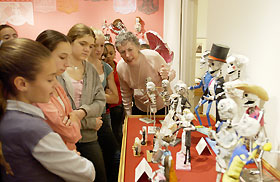Benton Museum Docents Communicate
Their Love of the Arts
 |
|
Madge Manfred, a docent at the William Benton Museum of Art, gives eighth-graders from Woodrow Wilson Middle School in Middletown a tour of the Mexican Day of the Dead exhibit. |
|
Photo by Peter Morenus
|
A group of 20 sixth-graders gather around Madge Manfred outside the Gilman Gallery
in the William Benton Museum of Art. Some stand on their tiptoes, eager
to catch a glimpse of
the exhibit.
“What do you know about the Mexican Day of the Dead?” asks Manfred.
“It’s like a Spanish Halloween,” says a youngster. “It’s a time to celebrate their dead relatives,” says another.
Colorfully decorated skeletons of all sizes, flowers, candles, and lustrous sugar skulls elicit oohs and aahs from the children, who have come from Anatolini Elementary School in New Hartford to see the Mexican Day of the Dead exhibit. Manfred, a docent at the Benton museum, is their guide.
“Have you been studying Spanish?” Manfred asks the group. Some shout
out yes, while others shake their heads. She leads the children to a large table
packed with an elaborate display of candles, glittery skulls,
flowers, photographs, crosses,
fruit, cans of soda, and a variety of other trinkets.
“This is a re-creation of an altar that would be made in someone’s house,” she says. “They put on the altar what the person liked in real life.” One child notices a pack of cigarettes among the clutter. “Why do you suppose that’s on the altar?” Manfred asks. “The person must have been a smoker,” says a youngster.
Manfred, a retired teacher, has been a docent for the past year. “I love it,” she says. “I get to use my teaching skills, and there’s always something new to learn.”
Manfred is among some 20 docents who volunteer their time giving tours and providing educational programs to people ranging from schoolchildren to senior citizens.
“The docent program is the perfect volunteer job for someone who loves the arts,” says Tracy Lawlor, educational coordinator at the Benton and director of the docent program. “The combination of loving art and enjoying working with people is the key ingredient in becoming a good docent. They are really the museum’s ambassadors to the public.” Docents do not need a degree in art to participate in the program.
Training includes attending a 2 1 / 2 hour class held Tuesday mornings from
mid-September through mid-May. Lawlor, along with museum
curators and guest speakers, give informal classes in art history and basic
teaching techniques.
“Volunteers learn about artists, mediums and techniques, the social and political aspects of the time period in which the art was created, as well as how to work with different age groups,” Lawlor says. Often teachers request hands-on activities to complement the tours. Activities have included making clay masks, paper molas that mimic colorful textile pieces made by the Cuna women of Panama, and storytelling and poetry writing after examining a painting. Youngsters have also enjoyed scavenger hunts and detective games.
Teachers sometimes feel inhibited about bringing their classes to a museum because they’re not sure of themselves when it comes to looking at art, Lawlor says. “We make it a point to let people know that when it comes to the content of art, there are no wrong answers.”
Tours are always interactive, Lawlor says. “That’s how people learn and retain information,” she says. “So our docents learn methods of facilitating questions that lead our visitors to the points we want to make during an exhibit. We’ve gotten into some wonderful discussions using this method.”
Once the training and mentoring phases are completed, docents are given tour assignments for groups of children or adults. On average, docents give two to three tours a month. They may also present talks to schools and community groups or prepare background information for exhibits.
Lawlor encourages UConn students to become docents. “It’s a great experience for those in education, the arts, and many other fields,” she says.
There is also a junior docent program at the Benton for students in grades 6 through 12. These younger volunteers give tours to other students.
Meryl Kogan has been a docent since 1988. The former mathematical statistics instructor and analyst at UConn’s Office of Institutional Research says she is “captivated” by analyzing art and what goes into creating works of art. She says she also appreciates “the avenues it has given me to make different friends among the docents.”
Sue Meisler says docents encourage people to think about what they see.
“We provide visitors with the tools to look critically at and beyond what is immediately apparent in a work of art,” she says. A docent since 2001, she is coordinator of children’s programs at Manchester Community College.
Meisler recalls asking the question, “What is art?” to a group of youngsters who visited the Benton. “A fourth grader said, ‘Art is what’s inside of me and wants to come out.’ It was a joy to make that kind of connection,” she says.
Those interested in becoming a docent may call Lawlor at 860.486.1711.

